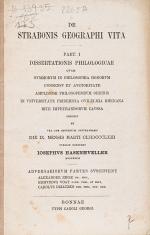[Strabo, De Strabonis Geographi Vita.
De Strabonis Geographi Vita. Part I.
Bonn, Carl Georgi, 1863. 8°. 37 Seiten. Softcover / Titelbroschur. Sehr guter Zustand.
Es handelt sich hier um die originale Doktorarbeit.
Strabo (Strábon; 64 or 63 BC – c. AD 24) was a Greek geographer, philosopher, and historian who lived in Asia Minor during the transitional period of the Roman Republic into the Roman Empire.
Strabo is most notable for his work Geographica (″Geography”), which presented a descriptive history of people and places from different regions of the world known to his era. Map of Europe according to Strabo.
Although the Geographica was rarely utilized in its contemporary antiquity, a multitude of copies survived throughout the Byzantine Empire. It first appeared in Western Europe in Rome as a Latin translation issued around 1469. The first Greek edition was published in 1516 in Venice. Isaac Casaubon, classical scholar and editor of Greek texts, provided the first critical edition in 1587.
Although Strabo cited the antique Greek astronomers Eratosthenes and Hipparchus, acknowledging their astronomical and mathematical efforts towards geography, he claimed that a descriptive approach was more practical, such that his works were designed for statesmen who were more anthropologically than numerically concerned with the character of countries and regions.
As such, Geographica provides a valuable source of information on the ancient world, especially when this information is corroborated by other sources. He traveled extensively, as he says: “Westward I have journeyed to the parts of Etruria opposite Sardinia; towards the south from the Euxine to the borders of Ethiopia; and perhaps not one of those who have written geographies has visited more places than I have between those limits.” We do not know when he wrote the Geography, but we know that he spent a lot of time in the famous library taking notes from his sources and his “the works of his predecessors” are most likely to have been noted at the library there. A first edition was published in 7 BC and a final edition no later than 23 AD, in the last year of Strabo’s life. The Geography, unfortunately, had an infinitesimal influence in his lifetime. It took about five years for scholars to give him a credit and for it to become a standard. In his last book of Geographica, he wrote quite extensively about the thriving port city of Alexandria. He emphasized that the harbor was well-encompassed by the embankments and that the shore was so deep-watered that even the largest ships could traverse. These ships were sent out to India, Ethiopia to supply them with products. Strabo juxtaposes Dichaiarchia (Naples- one of the largest ports in Europe) and Alexandria ports and says that the ships in Alexandria were clearly bigger. Thus, freight transporting and shipping were essential to foreign trade in products from all over the world, suggesting a highly developed local economy at that time. Strabo also describes the city itself. According to him, there were a lot of beautiful public parks and the city was reticulated with perfectly designed streets that were wide enough for chariots and horsemen. “Two of these are exceeding broad, over a plethron in breadth, and cut one another at right angles… All the buildings are connected one with another, and these also with what are beyond it.” Hence, the architecture was also developed in Egypt. (Wikipedia)
- Keywords: Altphilologie · Biografie · Biographie · Biography · Classical Literature – Rare · Geographie · Günstige Bücher · Latein · Latin · Original Thesis · Philologie · Philology · Strabo
- Language: Latin
- Inventory Number: 29036AB
EUR 68,--
© 2025 Inanna Rare Books Ltd. | Powered by HESCOM-Software












